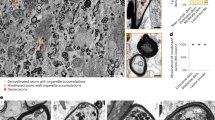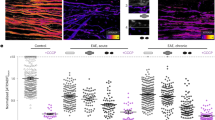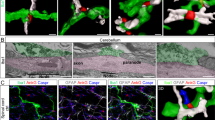Abstract
In multiple sclerosis, a common inflammatory disease of the central nervous system, immune-mediated axon damage is responsible for permanent neurological deficits1,2. How axon damage is initiated is not known. Here we use in vivo imaging to identify a previously undescribed variant of axon damage in a mouse model of multiple sclerosis. This process, termed 'focal axonal degeneration' (FAD), is characterized by sequential stages, beginning with focal swellings and progressing to axon fragmentation. Notably, most swollen axons persist unchanged for several days, and some recover spontaneously. Early stages of FAD can be observed in axons with intact myelin sheaths. Thus, contrary to the classical view2,3,4,5,6, demyelination—a hallmark of multiple sclerosis—is not a prerequisite for axon damage. Instead, focal intra-axonal mitochondrial pathology is the earliest ultrastructural sign of damage, and it precedes changes in axon morphology. Molecular imaging and pharmacological experiments show that macrophage-derived reactive oxygen and nitrogen species (ROS and RNS) can trigger mitochondrial pathology and initiate FAD. Indeed, neutralization of ROS and RNS rescues axons that have already entered the degenerative process. Finally, axonal changes consistent with FAD can be detected in acute human multiple sclerosis lesions. In summary, our data suggest that inflammatory axon damage might be spontaneously reversible and thus a potential target for therapy.
This is a preview of subscription content, access via your institution
Access options
Subscribe to this journal
Receive 12 print issues and online access
$209.00 per year
only $17.42 per issue
Buy this article
- Purchase on SpringerLink
- Instant access to full article PDF
Prices may be subject to local taxes which are calculated during checkout




Similar content being viewed by others
References
Hauser, S.L. & Oksenberg, J.R. The neurobiology of multiple sclerosis: genes, inflammation, and neurodegeneration. Neuron 52, 61–76 (2006).
Trapp, B.D. & Nave, K.A. Multiple sclerosis: an immune or neurodegenerative disorder? Annu. Rev. Neurosci. 31, 247–269 (2008).
Trapp, B.D. et al. Axonal transection in the lesions of multiple sclerosis. N. Engl. J. Med. 338, 278–285 (1998).
Lucchinetti, C. et al. Heterogeneity of multiple sclerosis lesions: implications for the pathogenesis of demyelination. Ann. Neurol. 47, 707–17 (2000).
Trapp, B.D. & Stys, P.K. Virtual hypoxia and chronic necrosis of demyelinated axons in multiple sclerosis. Lancet Neurol. 8, 280–291 (2009).
Waxman, S.G. Axonal conduction and injury in multiple sclerosis: the role of sodium channels. Nat. Rev. Neurosci. 7, 932–941 (2006).
Pitt, D., Werner, P. & Raine, C.S. Glutamate excitotoxicity in a model of multiple sclerosis. Nat. Med. 6, 67–70 (2000).
Medana, I., Martinic, M.A., Wekerle, H. & Neumann, H. Transection of major histocompatibility complex class I-induced neurites by cytotoxic T lymphocytes. Am. J. Pathol. 159, 809–815 (2001).
Smith, K.J., Kapoor, R., Hall, S.M. & Davies, M. Electrically active axons degenerate when exposed to nitric oxide. Ann. Neurol. 49, 470–476 (2001).
Lo, A.C., Saab, C.J., Black, J.A. & Waxman, S.G. Phenytoin protects spinal cord axons and preserves axonal conduction and neurological function in a model of neuroinflammation in vivo. J. Neurophysiol. 90, 3566–3571 (2003).
Friese, M.A. et al. Acid-sensing ion channel-1 contributes to axonal degeneration in autoimmune inflammation of the central nervous system. Nat. Med. 13, 1483–1489 (2007).
Mathey, E.K. et al. Neurofascin as a novel target for autoantibody-mediated axonal injury. J. Exp. Med. 204, 2363–2372 (2007).
Bittner, S. et al. TASK1 modulates inflammation and neurodegeneration in autoimmune inflammation of the central nervous system. Brain 132, 2501–2516 (2009).
Kerschensteiner, M., Schwab, M.E., Lichtman, J.W. & Misgeld, T. In vivo imaging of axonal degeneration and regeneration in the injured spinal cord. Nat. Med. 11, 572–577 (2005).
Misgeld, T. & Kerschensteiner, M. In vivo imaging of the diseased nervous system. Nat. Rev. Neurosci. 7, 449–463 (2006).
Bartholomäus, I. et al. Effector T cell interactions with meningeal vascular structure in nascent autoimmune CNS lesions. Nature 462, 94–98 (2009).
Siffrin, V. et al. In vivo imaging of partially reversible TH17 cell–induced neuronal dysfunction in the course of encephalomyelitis. Immunity 33, 424–436 (2010).
Feng, G. et al. Imaging neuronal subsets in transgenic mice expressing multiple spectral variants of GFP. Neuron 28, 41–51 (2000).
Misgeld, T., Kerschensteiner, M., Bareyre, F.M., Burgess, R.W. & Lichtman, J.W. Imaging axonal transport of mitochondria in vivo. Nat. Methods 4, 559–561 (2007).
Singbartl, K. et al. A CD2-green fluorescence protein–transgenic mouse reveals very late antigen-4–dependent CD8+ lymphocyte rolling in inflamed venules. J. Immunol. 166, 7520–7526 (2001).
Jung, S. et al. Analysis of fractalkine receptor CX3CR1 function by targeted deletion and green fluorescent protein reporter gene insertion. Mol. Cell. Biol. 20, 4106–4114 (2000).
Kapoor, R., Davies, M., Blaker, P.A., Hall, S.M. & Smith, K.J. Blockers of sodium and calcium entry protect axons from nitric oxide-mediated degeneration. Ann. Neurol. 53, 174–180 (2003).
Smith, K.J. & Lassmann, H. The role of nitric oxide in multiple sclerosis. Lancet Neurol. 1, 232–241 (2002).
Lin, M.T. & Beal, M.F. Mitochondrial dysfunction and oxidative stress in neurodegenerative diseases. Nature 443, 787–795 (2006).
Coleman, M. Axon degeneration mechanisms: commonality amid diversity. Nat. Rev. Neurosci. 6, 889–898 (2005).
Franklin, R.J. & Ffrench-Constant, C. Remyelination in the CNS: from biology to therapy. Nat. Rev. Neurosci. 9, 839–855 (2008).
Coman, I. et al. Nodal, paranodal and juxtaparanodal axonal proteins during demyelination and remyelination in multiple sclerosis. Brain 129, 3186–3195 (2006).
Aboul-Enein, F., Weiser, P., Höftberger, R., Lassmann, H. & Bradl, M. Transient axonal injury in the absence of demyelination: a correlate of clinical disease in acute experimental autoimmune encephalomyelitis. Acta Neuropathol. 111, 539–547 (2006).
Das Sarma, J., Kenyon, L.C., Hingley, S.T. & Shindler, K.S. Mechanisms of primary axonal damage in a viral model of multiple sclerosis. J. Neurosci. 29, 10272–10280 (2009).
Kroemer, G., Galluzzi, L. & Brenner, C. Mitochondrial membrane permeabilization in cell death. Physiol. Rev. 87, 99–163 (2007).
Dutta, R. et al. Mitochondrial dysfunction as a cause of axonal degeneration in multiple sclerosis patients. Ann. Neurol. 59, 478–489 (2006).
Mahad, D., Ziabreva, I., Lassmann, H. & Turnbull, D. Mitochondrial defects in acute multiple sclerosis lesions. Brain 131, 1722–1735 (2008).
Mahad, D.J. et al. Mitochondrial changes within axons in multiple sclerosis. Brain 132, 1161–1174 (2009).
Forte, M. et al. Cyclophilin D inactivation protects axons in experimental autoimmune encephalomyelitis, an animal model of multiple sclerosis. Proc. Natl. Acad. Sci. USA 104, 7558–7563 (2007).
Du, H. et al. Cyclophilin D deficiency attenuates mitochondrial and neuronal perturbation and ameliorates learning and memory in Alzheimer′s disease. Nat. Med. 14, 1097–1105 (2008).
D'Autréaux, B. & Toledano, M.B. ROS as signalling molecules: mechanisms that generate specificity in ROS homeostasis. Nat. Rev. Mol. Cell Biol. 8, 813–824 (2007).
Hooper, D.C. et al. Uric acid, a peroxynitrite scavenger, inhibits CNS inflammation, blood-CNS barrier permeability changes and tissue damage in a mouse model of multiple sclerosis. FASEB J. 14, 691–698 (2000).
Kizelsztein, P., Ovadia, H., Garbuzenko, O., Sigal, A. & Barenholz, Y. Pegylated nanoliposomes remote-loaded with the antioxidant tempamibe ameliorate experimental autoimmune encephalomyelitis. J. Neuroimmunol. 213, 20–25 (2009).
Lipton, S.A. Pathologically activated therapeutics for neuroprotection. Nat. Rev. Neurosci. 8, 803–808 (2007).
Abdul-Majid, K.B. et al. Screening of several H-2 congenic mouse strains identified H-2(q) mice as highly susceptible to MOG-induced EAE with minimal adjuvant requirement. J. Neuroimmunol. 111, 23–33 (2000).
Acknowledgements
We would like to thank B. Fiedler, G. Heitmann, M. Schedensack, A. Schmalz and S. Knecht for excellent technical assistance; D. Matzek for animal husbandry; A. Dagkalis for help with immunizations; M. Krumbholz for advice on statistical analysis; and R. Hohlfeld, H. Wekerle, J. Sanes, J. Lichtman, L. Godinho, D. Kerschensteiner, P. Williams, T. Dick, E. Meinl and K. Dornmair for discussions or critical reading of the manuscript. Work in M. Kerschensteiner's laboratory is financed through grants from the Deutsche Forschungsgemeinschaft (DFG; Emmy Noether Program and Sonderforschungsbereich 571) and the 'Verein Therapieforschung für MS-Kranke e.V'. M. Kerschensteiner and W.B. are supported by a grant from the German Federal Ministry of Education and Research (Competence Network Multiple Sclerosis). T.M. is supported by the Institute for Advanced Study, Technische Universität München, by the Alexander von Humboldt Foundation and by the Center for Integrated Protein Science (Munich). D.M. and W.B. are supported by grants from the DFG (Sonderforschungsbereich Transregio 43). D.M. is supported by the Swiss National Science Foundation (PP00P3 128372). D.B. is supported by the US National Institutes of Health. This project was further financed by grants to M. Kerschensteiner and T.M. from the Dana Foundation and the Hertie Foundation, and by a grant from the Christopher and Dana Reeve Foundation to T.M. and D.B.
Author information
Authors and Affiliations
Contributions
M. Kerschensteiner, T.M., D.B., D.M. and I.N. conceived the experiments. I.N. and C.S. did the imaging experiments. I.N., C.S., T.M. and M. Kerschensteiner did image analysis. M.B. and D.B. did and evaluated serial electron microscopy. I.N. and F.M.B. did therapy experiments. D.M., M. Kreutzfeldt and W.B. did histopathological evaluations of EAE and multiple sclerosis tissue. I.N., M. Kerschensteiner and T.M. wrote the paper.
Corresponding authors
Ethics declarations
Competing interests
The authors declare no competing financial interests.
Supplementary information
Supplementary Text and Figures
Supplementary Figures 1–5 and Supplementary Methods (PDF 894 kb)
Supplementary Video 1
In vivo multi-photon time-lapse that illustrates the degeneration of a transgenically labeled stage 1 axon (white) in an acute EAE lesion in a Thy1-CFP-S × Cx3cr1GFP/+ mouse. Axonal degeneration is initiated near a putative node of Ranvier in close proximity to activated macrophages/microglia (magenta). (MOV 409 kb)
Supplementary Video 2
In vivo overview multi-photon time-lapse of the healthy lumbar spinal cord of a Thy1-YFP-16 (× Thy1-MitoCFP-P) mouse in which axons are labeled with YFP (gray). The video illustrates that no obvious morphological changes are induced by our imaging approach. 300 min, 11 frames. (MOV 1533 kb)
Supplementary Video 3
In vivo overview multi-photon time-lapse of the lumbar spinal cord of a Thy1-YFP-16 (× Thy1-MitoCFP-P) mouse, in which axons are labeled with YFP (gray; in some axons, CFP-labeled mitochondria are visible due to spectral cross-talk) 2 d after the EAE onset. The video illustrates stage 1 to stage 2 transitions in three axons during the observation period. 300 min, 11 frames. (MOV 2253 kb)
Supplementary Video 4
In vivo multi-photon time-lapse of the lumbar spinal cord of a Thy1-YFP-16 (× Thy1-MitoCFP-P) mouse in which the axons are labeled with YFP (gray) 3 d after the EAE onset. This video illustrates the recovery of a stage 1 axon during the observation period. 330 min, 11 frames. (MOV 263 kb)
Supplementary Video 5
Video sequence of a stage 1 EAE axon (shown in Fig. 2a–d) that illustrates the correlation between in vivo multi-photon imaging and ssTEM. (MOV 3002 kb)
Supplementary Video 6
In vivo multi-photon microscopy time-lapse of an activated macrophage/microglia (one cell was manually pseudo-colored in magenta based on GFP expression) in apposition to an axon (white) in an acute EAE lesion in a Cx3cr1GFP/+ × Thy1-CFP-S mouse. The video illustrates how immune cells tracts were generated from time-lapse sequences. Note transition of the apposed axon from stage 0 to stage 1 during the time-lapse. Asterisk in first frame marks additional macrophage/microglia. 192 min, 20 frames. (MOV 180 kb)
Supplementary Video 7
In vivo multi-photon time-lapse of a T cell (one cell was manually pseudo-colored in cyan based on GFP expression) in apposition to an axon (white) in an acute EAE lesion in a Thy1-CFP-S × Cd2-GFP mouse. The video illustrates how immune cells tracts were generated from time-lapse sequences. Green asterisk in first frame marks additional T cell, gray asterisk marks axon fragment. 40 min, 27 frames. (MOV 249 kb)
Supplementary Video 8
In vivo multi-photon time-lapse of axonal (white) and mitochondrial (cyan) changes induced after application of H2O2 (330 mM) to the spinal cord of a Thy1-YFP-16 × Thy1-MitoCFP-P mouse. Note that axonal mitochondria change before the transition of the axons from stage 0 to stage 1. (MOV 1088 kb)
Rights and permissions
About this article
Cite this article
Nikić, I., Merkler, D., Sorbara, C. et al. A reversible form of axon damage in experimental autoimmune encephalomyelitis and multiple sclerosis. Nat Med 17, 495–499 (2011). https://doi.org/10.1038/nm.2324
Received:
Accepted:
Published:
Issue Date:
DOI: https://doi.org/10.1038/nm.2324
This article is cited by
-
Identification of common genetic factors and immune-related pathways associating more than two autoimmune disorders: implications on risk, diagnosis, and treatment
Genomics & Informatics (2024)
-
Pathological ultrastructural alterations of myelinated axons in normal appearing white matter in progressive multiple sclerosis
Acta Neuropathologica Communications (2023)
-
Lack of myelin improves axon survival in inflammatory lesions in the CNS
Nature Neuroscience (2023)
-
Tissue-resident immune cells in the pathogenesis of multiple sclerosis
Inflammation Research (2023)
-
Inflammatory Cytokines Associated with Multiple Sclerosis Directly Induce Alterations of Neuronal Cytoarchitecture in Human Neurons
Journal of Neuroimmune Pharmacology (2023)



